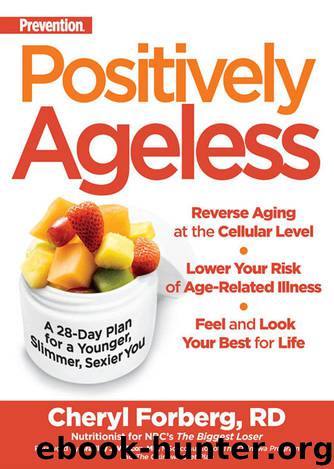Positively Ageless by Cheryl Forberg

Author:Cheryl Forberg [Cheryl Forberg]
Language: eng
Format: epub
ISBN: 9781605299112
Publisher: Rodale
Published: 2008-03-15T00:00:00+00:00
The Positively Ageless Guide to Preventing Strokes
For detailed information on how to follow the principles of a heart-healthy diet that protects your brain, refer back to the tips in the heart section. In short, though, remember to:
Keep your blood pressure low. This will help lower your risk of hemorrhagic strokes and help cut down on atherosclerosis, one of the processes that underlie ischemic strokes. 47 To help lower blood pressure, eat a diet rich in potassium—fruits and vegetables are a great source—and low in sodium. Cut down on processed foods and toss out your saltshaker. Exercising regularly, avoiding smoking, and keeping your weight at a normal level are important for good blood pressure, too. Finally, hold your alcohol consumption to one drink a day.
Keep your LDL low and your HDL high. Keeping your cholesterol in check is an important step toward preventing atherosclerosis. 47 This means limiting saturated fat, such as in red meat and full-fat dairy, and emphasizing healthier oils such as olive, canola, and flaxseed. Cut out trans fat, found in processed baked goods. And eat your fish! The omega-3s in salmon, sardines, and some other fish may help protect you from stroke. A diet rich in fiber (especially soluble fiber) also helps reduce bad cholesterol, while regular exercise helps both lower your LDL and raise your HDL cholesterol.
Limit dietary cholesterol. If you’re at high risk of vascular disease, you should limit yourself to 200 milligrams of dietary cholesterol daily. If you’re not at high risk, you can have 300 milligrams daily. You won’t find dietary cholesterol in plant foods—only animal foods like egg yolks, meat, and some seafood, including shrimp. 50
Eat your antioxidants. You learned earlier that LDL cholesterol in artery walls can become oxidized by free radicals, which contributes to the accumulation of immune-system cells and other substances during the process of atherosclerosis. Eating foods high in antioxidants like vitamin C and vitamin E will help protect you. 50
Taking single antioxidants in supplement form isn’t the answer, though. Different kinds of fruits and vegetables contain a tremendous variety of antioxidants and phytochemicals that work in concert to protect you. Nutrition experts have barely scratched the surface of knowing what these food components do individually, let alone in teams. Blueberries alone contain more than 300 different plant chemicals.
Antioxidants often provide the color, scent, and flavor in fruits and vegetables, so going for an ever-shifting palette of colors will offer the variety you need for steady protection from free radicals while keeping your menus delicious and interesting. 50
Prevent diabetes damage. Reducing your risk of diabetes—or carefully controlling your blood sugar if you have the condition—will make you less likely to have a stroke. 47 The damage that high blood sugar does to your blood vessels encourages atherosclerosis. As said before, maintaining a healthy weight and getting regular exercise can help you prevent or treat diabetes. Eating several small meals throughout the day, including protein with each meal and snack, and focusing on complex carbohydrates rather than processed “white” carbs will help keep your blood sugar stable.
Download
This site does not store any files on its server. We only index and link to content provided by other sites. Please contact the content providers to delete copyright contents if any and email us, we'll remove relevant links or contents immediately.
How to Be a Bawse: A Guide to Conquering Life by Lilly Singh(7382)
Deep Work by Cal Newport(6873)
The Longevity Diet by Valter Longo(5017)
The Fat Loss Plan by Joe Wicks(4845)
The Four-Pack Revolution by Chael Sonnen & Ryan Parsons(3932)
The Ultimate Bodybuilding Cookbook by Kendall Lou Schmidt(3884)
The French Women Don't Get Fat Cookbook by Mireille Guiliano(3604)
Super Food Family Classics by Jamie Oliver(3366)
Not a Diet Book by James Smith(3335)
Factfulness_Ten Reasons We're Wrong About the World_and Why Things Are Better Than You Think by Hans Rosling(3197)
Turn Up Your Fat Burn! by Alyssa Shaffer(3182)
Self-Esteem by Matthew McKay & Patrick Fanning(3091)
Tom Kerridge's Dopamine Diet: My low-carb, stay-happy way to lose weight by Kerridge Tom(3063)
Body Love by Kelly LeVeque(3012)
The Unbecoming of Mara Dyer by Michelle Hodkin(2998)
The Fat Chance Cookbook by Robert H. Lustig(2791)
Tone Your Tummy Type by Denise Austin(2785)
LL Cool J's Platinum 360 Diet and Lifestyle by LL Cool J(2685)
Men's Health Best by Men's Health Magazine(2551)
